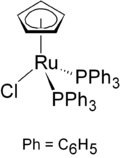Chemistry:Chloro(cyclopentadienyl)bis(triphenylphosphine)ruthenium

| |

| |
| Identifiers | |
|---|---|
3D model (JSmol)
|
|
| ChemSpider | |
PubChem CID
|
|
| |
| |
| Properties | |
| C41H35ClP2Ru | |
| Molar mass | 726.19 g/mol |
| Appearance | Orange solid |
| Melting point | 135 °C (275 °F; 408 K) |
| Insoluble | |
| Hazards | |
| GHS pictograms | 
|
| GHS Signal word | Warning |
| H302, H312, H315, H319, H332, H335 | |
| P261, P264, P270, P271, P280, P301+312, P302+352, P304+312, P304+340, P305+351+338, P312, P321, P322, P330, P332+313, P337+313, P362, P363, P403+233, P405, P501 | |
Except where otherwise noted, data are given for materials in their standard state (at 25 °C [77 °F], 100 kPa). | |
| Infobox references | |
Chloro(cyclopentadienyl)bis(triphenylphosphine)ruthenium is the organoruthenium half-sandwich compound with formula RuCl(PPh3)2(C5H5). It as an air-stable orange crystalline solid that is used in a variety of organometallic synthetic and catalytic transformations. The compound has idealized Cs symmetry. It is soluble in chloroform, dichloromethane, and acetone.
Preparation
Chloro(cyclopentadienyl)bis(triphenylphosphine)ruthenium was first reported in 1969 when it was prepared by reacting dichlorotris(triphenylphosphine)ruthenium(II) with cyclopentadiene.[1]
- RuCl2(PPh3)3 + C5H6 → RuCl(PPh3)3(C5H5) + HCl
It is prepared by heating a mixture of ruthenium(III) chloride, triphenylphosphine, and cyclopentadiene in ethanol.[2]
Reactions
Chloro(cyclopentadienyl)bis(triphenylphosphine)ruthenium(II) undergoes a variety of reactions often by involving substitution of the chloride. With phenylacetylene it gives the phenyl vinylidene complex:
- (C5H5)(PPh3)2RuCl + HC2Ph + NH4[PF6] → [Ru(C:CHPh)(PPh3)2(C5H5)][PF6] + NH4Cl
Displacement of one PPh3 by carbon monoxide affords a chiral compound.[3]
- (C5H5)(PPh3)2RuCl + CO → (C5H5)(PPh3)(CO)RuCl + PPh3
The compound can also be converted into the hydride:[4]
- (C5H5)(PPh3)2RuCl + NaOMe → (C5H5)(PPh3)2RuH + NaCl + CH2O
A related complex is tris(acetonitrile)cyclopentadienylruthenium hexafluorophosphate, which has three labile MeCN ligands.
Applications
Chloro(cyclopentadienyl)bis(triphenylphosphine)ruthenium(II) serves as a catalyst for a variety of specialized reactions. For example, in the presence of NH4PF6 it catalyzes the isomerisation of allylic alcohols to the corresponding saturated carbonyls.[5]
References
- ↑ "New Complexes of Ruthenium(II) with Triphenylphosphine and other Ligands". J. Chem. Soc.: 1749. 1969. doi:10.1039/J19690001749.
- ↑ Bruce, M. I.; Hamiester, C., Swincer, A. G., Wallis, R. C. "Some η5-Cyclopentadienylruthenium(II) Complexes Containing Triphenylphosphine" Inorganic Syntheses 1982, volume 21, pp 78-82. doi:10.1002/9780470132524
- ↑ "Some New η-Cyclopentadienyltuthenium Complexes". J. Chem. Soc. A: 2376–2382. 1971. doi:10.1039/J19710002376.
- ↑ Wilczewski, T.; Bochenska, M.; Biernat, J. (1981). "Cyclobentadienyl-Ruthenium Complexes". J. Organomet. Chem. 215: 87–96. doi:10.1016/S0022-328X(00)84619-7.
- ↑ Murahashi, Shun-Ichi. "Ruthenium in Organic Synthesis" (2006) Wiley-VCH: Weinheim. ISBN:978-3-527-30692-3
 |

